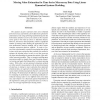151 search results - page 19 / 31 » Learning patterns in the dynamics of biological networks |
CONNECTION
2006
13 years 7 months ago
2006
Models of associative memory usually have full connectivity or if diluted, random symmetric connectivity. In contrast, biological neural systems have predominantly local, non-symm...
AINA
2008
IEEE
14 years 2 months ago
2008
IEEE
The analysis of gene expression time series obtained from microarray experiments can be effectively exploited to understand a wide range of biological phenomena from the homeostat...
BMCBI
2007
13 years 7 months ago
2007
Background: Gene expression is governed by complex networks, and differences in expression patterns between distinct biological conditions may therefore be complex and multivariat...
GECCO
2007
Springer
14 years 1 months ago
2007
Springer
Connectivity patterns in biological brains exhibit many repeating motifs. This repetition mirrors inherent geometric regularities in the physical world. For example, stimuli that ...
SIGMOD
2003
ACM
14 years 8 months ago
2003
ACM
Finding patterns in large, real, spatio/temporal data continues to attract high interest (e.g., sales of products over space and time, patterns in mobile phone users; sensor netwo...

